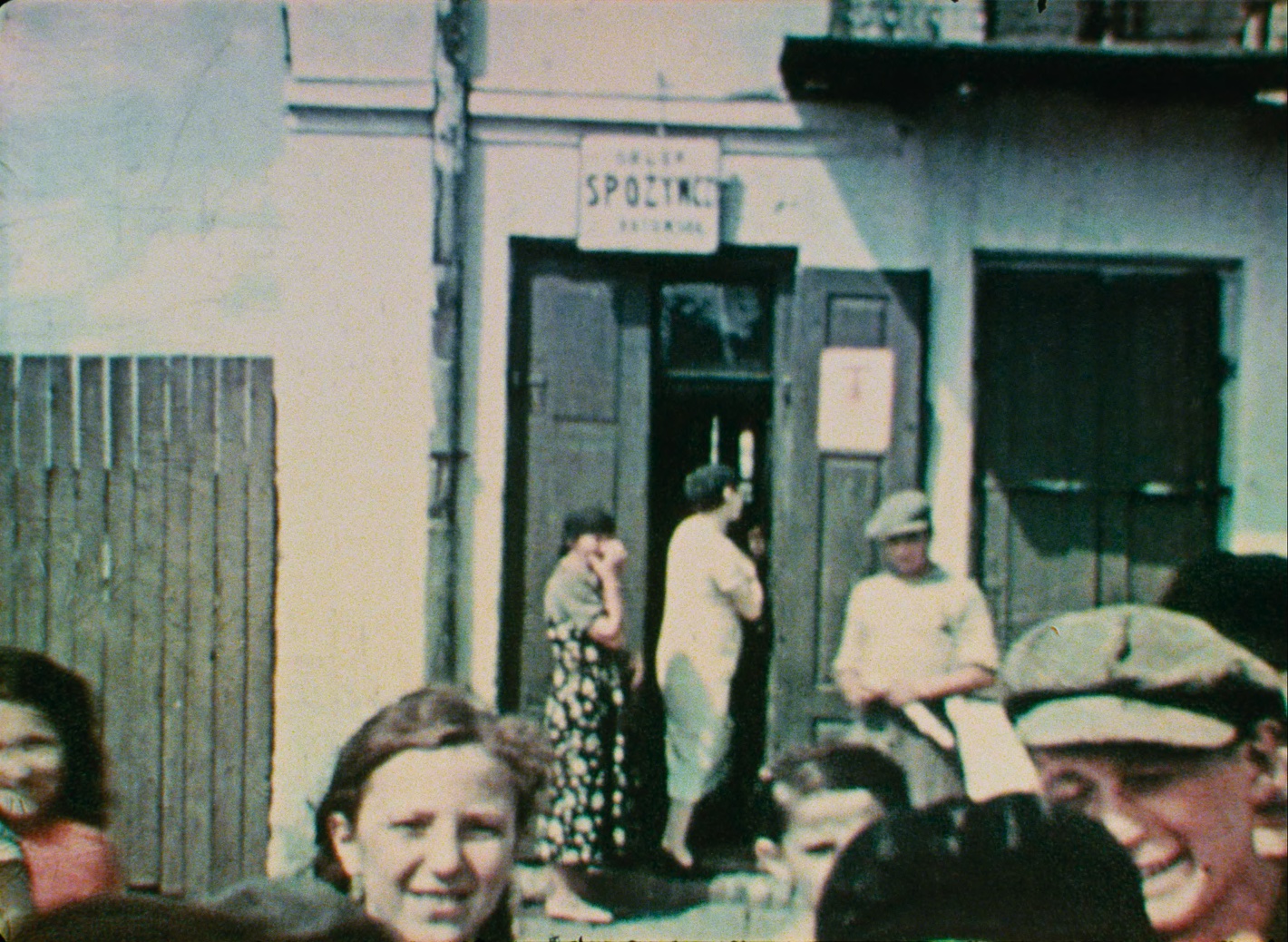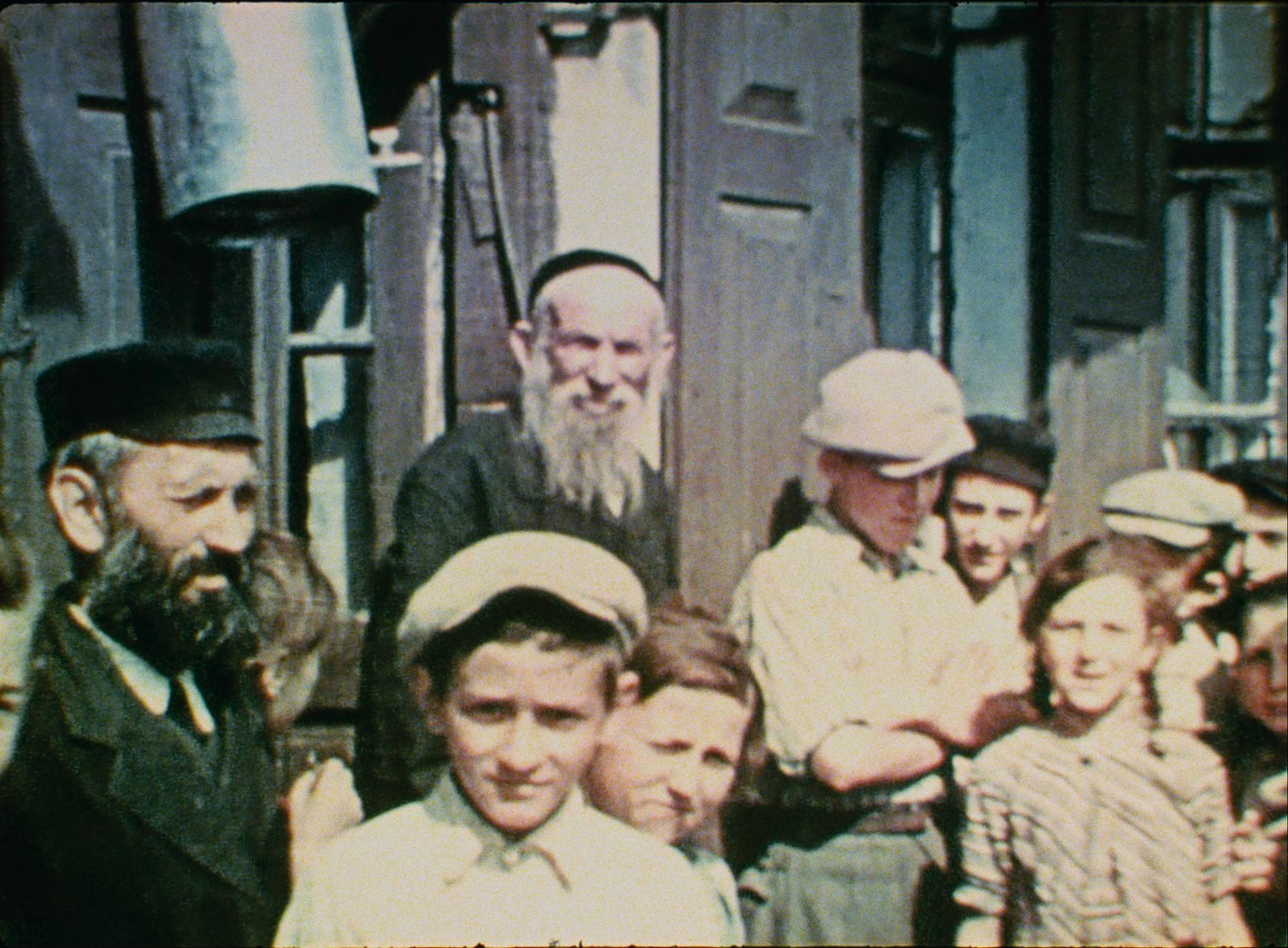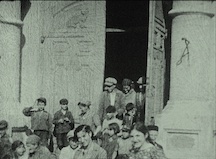Holidaying in Europe with his wife Lisa and friends in August 1938, David Kurtz of Flatbush, Brooklyn, whose family left Poland in 1892 when he was four, returned to his hometown of Nasielsk (population 7,000), 33 miles north-west of Warsaw. There, as an amateur cameraman, he unwittingly made a brief away-from-home movie that would prove to have unimaginable emotional power.
With his new 16mm Ciné-Kodak camera, Kurtz recorded three minutes of footage in his old Jewish community around the Nasielsk town square. People poured outdoors or lingered where they were to be filmed. Many of them were children and adolescents who smiled, mugged, and jostled each other.
No one present knew that 16 months later, on 3 December 1939, German soldiers armed would brutally herd Nasielk's 3,000 Jews to the local railway station for deportation and ghettoisation. The majority would be killed in Treblinka. About eighty survived the Nazi extermination.
Shortty before it decayed irreparably, Kurtz's footage was discovered by his grandson, New York City-based author and professor Glenn Kurtz, in a cupboard in his parents' Florida home in 2008. He could tell from a segment that had been transferred to VHS that it was invaluable. He sent it to the US Holocaust Memorial Museum to be restored, traced seven of the survivors, and wrote a book, Three Minutes in Poland: Discovering a Lost World in a 1938 Family Film (2014), on what the footage revealed.
The book and the footage inspired the Dutch historian Bianca Stigter to direct the documentary Three Minutes: A Lengthening. It is a formidable work of investigation and memorialisation precisely because Stigter shot nothing new for it but relies on David Kurtz's three minutes of film, which she parsed forensically to identify as much as possible the people and places it shows. Few gave up their names, but one who did was then-13-year-old Maurice Chandler, whose voice as a nonagenarian joins Glenn Kurtz's and narrator Helena Bonham Carter's on the soundtrack.
A quietly spoken but voluble interviewee, Stigter – who served as associate producer on her artist-filmmaker husband Steve McQueen's 12 Years a Slave (2013) and Widows (2018) – talked at length to The Arts Desk ahead of tonight's UK Jewish Film Festival screening of Three Minutes: A Lengthening at London's Curzon Mayfair.
GRAHAM FULLER: When did you first see David Kurtz's footage and how did it affect you?
BIANCA STIGTER: I first saw it at the end of 2014 on the website of the Holocaust Memorial Museum where you can still see it today. I was alerted to it because of a post on Facebook about Glenn Kurtz’s book. It's a piece of film that immediately gives you a lot of conflicting emotions and thoughts. What made it special for me was that it’s in colour. Usually images from that part of history are black and white. Colour makes it feel contemporary, less far away than black and white. Then, of course, colour footage of a Jewish part of a town in Poland in the late 1930s is scarce.
 It shows these joyous scenes, especially of these kids who are trying to to stay in the frame. You really have the feeling that they are looking at you, so you feel very close to them in a way. At the same time, you feel very far away because you know what will happen to them soon after this material was filmed – and they don't. You want to scream, “Get out!” But they can't hear you because it's a piece of film.
It shows these joyous scenes, especially of these kids who are trying to to stay in the frame. You really have the feeling that they are looking at you, so you feel very close to them in a way. At the same time, you feel very far away because you know what will happen to them soon after this material was filmed – and they don't. You want to scream, “Get out!” But they can't hear you because it's a piece of film.
Did you think immediately that the footage should be brought to a wider public?
Yes, but it’s just three minutes – a fragment. I thought, Wouldn't it be great if we could somehow extend the experience of engaging with what we see? I wasn’t working as a filmmaker then, more as a film critic, but the Rotterdam film festival had just started its Critics' Choice program of video essays and asked me if I wanted to make one. I said to myself, OK, this is my chance to try to do something with this material. I very quickly contacted Glenn Kurtz and interviewed him and made a short film [Three Minutes Thirteen Minutes Thirty Minutes] we presented at the 2015 Rotterdam festival. But I still had the feeling I could do so much more with this material. So then I looked for a producer, and here we are seven years later.
Did you visit Nasielsk?
Yes. I knew that I just wanted to use the old footage and not film anything myself. But I went to Nasielsk to look around and to record the sounds of the town as it is now. The synagogue is gone but the houses are still there in the part of the square you see in the footage. They were difficult to recognize, though, because buildings can change more than you might imagine. When you look at the buildings by the canals in my hometown of Amsterdam, you might think they’re the same as they were three hundred years ago, but it’s not so – doors, windows, and stairs change and parts of other buildings can be put on top of them. We needed an old photo to confirm we’d found the exact location in Nasielsk. Linden trees are still there but they’re too small to be the ones that were there in the 1930s.
 And the mezuzahs shown in the film are gone? [Mezuzahs are decorative cases for parchment, inscribed with Hebrew verses from the Shema Yisrael prayer in the Torah, and fixed to doorposts.]
And the mezuzahs shown in the film are gone? [Mezuzahs are decorative cases for parchment, inscribed with Hebrew verses from the Shema Yisrael prayer in the Torah, and fixed to doorposts.]
I think a few might survive in the town. When I was there in 2018, there was still one in the school. But when I returned in May to screen the film in a cinema that existed in 1938 – and which is just a stone’s throw from where the footage was shot – I was told the mezuzah in the school had disappeared.
Such vestiges of Jewish community life in Europe are vitally important – all that remains.
The Nazis not only murdered the Jewish people, they also tried to erase the culture completely. What’s important for me is that anything we can find, or anything we can name, however trivial it might be, feels as if it’s a small victory against this erasure, and it gains importance.
One of the marvels of Three Minutes: A Lengthening is how you built on Glenn Kurtz’s detective work into his grandfather’s footage by both deconstructing and reconstructing it. For example, you created, frame by frame, a remarkable panoramic still from David Kurtz’s panning shot of so many of the Nasielsk Jews, mostly children, looking and smiling at the camera. Then there is the astonishing face-by-face assembly into a single image of all the people that appear in the film. How did these ideas come to you?
I wanted to get at the footage any which way I could. I had the idea for the [assembled] portraits very early on. The faces that appear in the film are often the only traces that are left of those people. We can't put names to most of them, which is a kind of indication by itself of the scale of the Holocaust. They are not background, they are foreground – and I wanted to make everyone, at least for a moment, be the center of attention.
After I first discussed this idea with the very good special effects man we worked with, he came back with forty faces or something. I said, "It looks really good, but where's everybody else?" And he said, "They're too blurry, or you can hardly see anything of them. I said, "For this purpose, it doesn't matter. The fact that they are blurry is telling if it's a last trace of someone, and that is what we should show and that is what we should honour." For me, making the film – but I hope also for people watching it – it should feel like you're partaking in some kind of memorial act.
I suspect different faces will resonate for every person who sees the film. I was very struck by the boy with the floppy cap who keeps looking at the camera as he walks away from it.
The boy in the black and white section? Yes, he has a kind of movie star quality.
He’s like a Dickens character. Then there's the girl with the pigtails and gentle smile who appears several times. If these young people had lived, many of them would have likely had children of their own five or six years afterwards. We think of the Holocaust as the six milliom who were killed, but it continues exponentially because of the millions unborn.
The way we structured the film was important. We begin with the three minutes of footage and [as a viewer] you don’t know anything about it. You think, What is this? And then you get all this new information as you see things over and over again. When you see the three minutes again at the end of the film, you have a totally different rapport with it because you recognize people.They are no longer anonymous. Even though we don't know their names, they have become individuals. The idea of the six million has, at least a little bit, ceased to be an abstraction because we can see that what happened to them happened to one person at a time.
You have a voiceover reading of an eyewitness account [taken from the Emanuel Ringelblum Archive] of the Nazis whipping Nasielsk’s Jews as they drive them across muddy ground to the railway station for deportation. The accompanying image is a blurred frame of the cobbles in the town square. If footage of that horrific event existed, would you have shown it?
 That’s a difficult question. Maybe not. You could say that's the kind of thing we didn’t have to show here because we had enough of other things to show. The eyewitness said that German soldiers took pictures while they were humiliating people in the square. We know those kind of pictures exist from other places, but none from Nasielska have been found. Who knows, they might still be in an attic in Hamburg or wherever.
That’s a difficult question. Maybe not. You could say that's the kind of thing we didn’t have to show here because we had enough of other things to show. The eyewitness said that German soldiers took pictures while they were humiliating people in the square. We know those kind of pictures exist from other places, but none from Nasielska have been found. Who knows, they might still be in an attic in Hamburg or wherever.
I felt we had to show their absence, in a way, so [viewers] can think about what kind of things are filmed and not filmed, or, if such images had been found, should they be shown or not shown. These kinds of ideas come into play.
is the Nasielsk survivor Maurice Chandler still alive?
Yes. He lives in Florida and Detroit, and I stayed with him in Detroit for a few days and we recorded his thoughts, which you hear in the film.
Has he seen the documentary?
Absolutely, and sometimes he’ll do a Q&A after a screening if he wants to. I think he is happy with it, but I know for sure he was happy to see the original footage. Most of the survivors believed they lost everything. Their families, their belongings, and the whole culture they came from were destroyed. Suddenly, for Mr. Chandler, there was a little fragment of film he could show to his children and say, “Now, you know I'm not from Mars but come from an actual place in an actual time, and this is what it was. And I was happy there.”
 This, for me also, is what makes the footage so special.. It’s not propaganda and it’s not even artistic. David Kurtz just knew how to operate his camera, and he put it on and let it roll. It gives you that incredible feeling of immediacy and authenticity because there's no filter of any kind. Of course, he changed how the people behaved and moved because they all wanted to be filmed.
This, for me also, is what makes the footage so special.. It’s not propaganda and it’s not even artistic. David Kurtz just knew how to operate his camera, and he put it on and let it roll. It gives you that incredible feeling of immediacy and authenticity because there's no filter of any kind. Of course, he changed how the people behaved and moved because they all wanted to be filmed.
People nowadays can relate to that experience, like when they take selfies. Whereas history books can never record these moments – how people shove each other and make funny faces – footage like this can make you notice a different part of the fabric of what is memorable about a place. It’s a testament to the raw power of film.
- Three Minutes: A Lengthening screens as part of the UK Jewish Film Festival on 12 November at Curzon Mayfair in London. Nationwide previews 30 November. The film arrives in cinemas and exclusively on Curzon Home Cinema on 2 December.
- More film on theartsdesk














Add comment